Thanks to everyone who joined us on the live-blog of the Next America event at the Newseum. We now have an archived video of it, including the two panels.
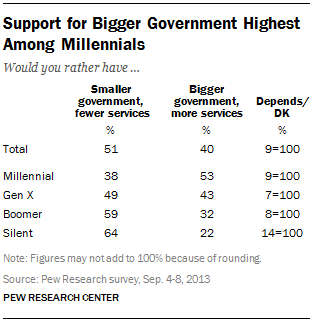
UPDATE, 1:18 p.m. An audience member asked how Millennials’ support for a more active government (53% say they favor a bigger government that provides more services, versus 38% who’d rather have a smaller government that provides fewer services) squares with their distrust of government and reluctance to affiliate with organized politics.
Pew Research’s Doherty responded that such seemingly contradictory views aren’t all that unusual, among Millennials or other population groups. Neera Tanden, president of the Center for American Progress, added that disinterest in affiliating with a political party is different from how you vote or how you feel about issues. She said it also reflects the long-running decline in parties’ institutional power and the role of non-party funders, consultants and other political infrastructure.
UPDATE, 1:07 p.m. Older people think of themselves as, for example, feminists or environmentalists because those identities were forged decades ago in fierce social struggles, GOP pollster Bill McInturff said. But Millennials, who came of age much later, eschew those labels even if they embrace the policy positions: “‘We wouldn’t fight about that.’ They just presume it to be true.”
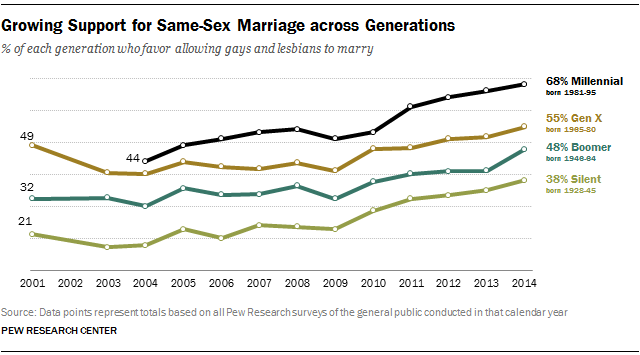
McInturff added that, given the strong generational skew on social issues, the same-sex marriage debate “is essentially over,” even if the political system will continue fighting over it for a few more years. That may be true of marijuana legalization too, he said, though the state-level experiments are at an earlier stage.

UPDATE, 12:58 p.m. The new Millennials report from Pew Research shows strong support across generations for maintaining Social Security benefits at current levels (even though half of Millennials and Gen-Xers say they don’t expect to receive any Social Security benefits when they retire). Debra Whitman of AARP says her group’s research has found that younger generations (Boomers and Gen-Xers) support Social Security because, with the erosion of defined-benefit pensions and 401(k)s whipsawed by the stock market, they’re counting on it more.
When it comes to student-loan debt relief, Aaron Smith of Young Invincibles expressed frustration that senators and representatives from older generations don’t understand how serious the problem is. “I’ve had people tell me, ‘I don’t understand why you can’t work over the summer to pay for college,’” Smith said. “They’re just not in touch with reality.”
UPDATE, 12:44 p.m. Despite their progressive tilt, Millennials may be up for grabs politically, said Aaron Smith, co-founder and executive director of Young Invincibles. “Neither political party has really articulated an economic vision that will address the challenges faced by young adults,” Smith said. “The solutions we’re seeing are sort of recycled solutions from the past.”
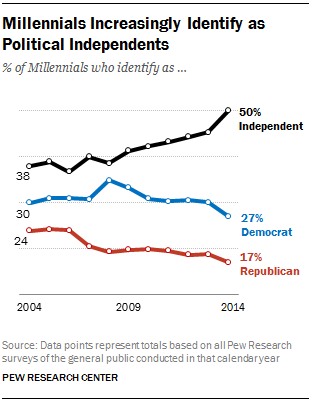
UPDATE, 12:35 p.m. Half of Millennials call themselves independent, versus 27% Democrats and 17% Republicans. “That’s a number you don’t often see,” said Carroll Doherty, director of political research at the Pew Research Center. But when you include those who “lean” toward one party or another, half identify with the Democratic Party versus 34% for the Republican Party.
Like other generations, Millennials express disappointment with the Obama administration. In 2009 they were the generation most likely to approve of Obama (70%), but their approval has now fallen to 49% — still higher than the Gen X, Boomer and Silent generations.
Millennials are at the leading edge of a number of social issues, Doherty said, from same-sex marriage (68% of Millennials support it) to marijuana legalization (69% of Millennials in favor) to immigration policy (Millennials are the only generation in which a majority, 55%, says unauthorized immigrants not only should be allowed to stay in the U.S. but also apply for citizenship.
UPDATE, 11:50 a.m. Breaking for lunch now — back in a half-hour or so with a panel on generations, politics and policy.
UPDATE, 11:40 a.m. How do you square the alleged risk-aversion of Millennials with the fact that their rate of unmarried motherhood is so high (47% in 2012, versus 21% of older women who gave birth last year)? Wilcox tied it to the idea that for many Millennials marriage is a capstone experience, while having kids is something that’s time-limited. (Later, Howe commented that “Fertility deferred is fertility denied.”) Huntsman added that said having kids seems a more meaningful experience to many Millennials than marriage.
UPDATE, 11:24 a.m. How to get Millennials engaged in the political process? Howe said “It’s going to take crisis to galvanize young people” politically. Huntsman said Millennials will get involved when politicians talk about issues that affect them directly, and/or when they find a candidate they genuinely like. Howe responded, “The last time we had a candidate people liked was the 1950s.”
UPDATE, 11:17 a.m. Huntsman, responding to Singletary, said she grew up in the LDS Church but now identifies more as spiritual rather than as a Mormon — an example, she said, of her generation’s reluctance to be labeled. Menendez picked up on that point, noting that Millennials often agree with policy positions but reject labels or identities associated with those positions: “Do you care about the planet? Yes. Do you want clean air and clean water for your kids ? Yes. Are you an environmentalist? No.”
UPDATE, 11:09 a.m. Alan Cooperman, director of the Pew Research Center’s Religion Project, said that Millennials are disaffiliating from religion. 32% of that generation are unaffiliated with a particular religion, versus 20% of the general population. And Millennials are less likely than older generations to describe themselves as spiritual rather than religious. “They’re less religious in just about any way you can think of.”
UPDATE, 10:59 a.m. Washington Post personal-finance columnist Michelle Singletary said it’s not wrong for Millennials to live at home after college if they need to the save money and pay down debt. Nor was it a mistake for them to go to college, even if they’re underemployed and carrying a heavy student-debt load now. “Going to college isn’t wrong. Going to college at any cost? That’s wrong.” Menendez added that that student-debt burden — with little relief from either the government or the private sector — is holding back Millennials from getting fully launched into their adult lives.
UPDATE:, 10:52 a.m. Abby Huntsman, co-host of “The Cycle” on MSNBC: “I’m very concerned for the future of the Republican Party. If you look at where the Republican Party stands on any number of issues, the Millennial generation is on the opposite side of that.”
Economist, historian and demographer Neil Howe said Millennials are in many ways a very risk-averse generation, and that risk aversion shows up everywhere from their distrust of social institutions to their reluctance to get married and buy homes. Brad Wilcox of the American Enterprise Institute said Millennials typically view marriage as the capstone, rather than the foundation stone, of their adult lives. Huntsman said one of her sisters lived at home for five years after graduating from college.
UPDATE, 10:42 a.m. Alicia Menendez, host of “Alicia Menendez Tonight” on Fusion TV, on the racial and ethnic diversity of her generation: “We don’t really think about it. It’s just the world we grew up in.”
UPDATE, 10:37 a.m. Younger adults today have less wealth than younger adults 20 years ago did; older adults today have more wealth than older adults did two decades. Younger adults also are significantly more likely to vote Democratic and more comfortable with social changes such as same-sex marriage and the prospect of legalizing unlawful immigrants.
Despite financial challenges and differing political and social views, the generations aren’t fated to battle each other. Why? “It’s hard to wage a generational war when you’re living under the same roof,” Taylor said. More than a fifth (22%) of households currently have more than two adult generations living in them, a level not seen since the end of World War II. And overall, only 29% of people say there are “strong” or “very strong” conflicts between the young and old, far fewer than say that about blacks and whites, rich and poor, immigrants and natives – or especially Democrats and Republicans (a whopping 81%).
UPDATE, 10:27 a.m. The Millennial generation stands out as the first generation in U.S. history to enter adulthood in worse economic shape than their parents. Their unemployment rate is higher (8.2%, versus 5.8% for Gen Xers at the same age range) and they have higher student debt.
UPDATE, 10:20 a.m. Another driver of diversity: intermarriage. Back in 1960, when intermarriage was illegal in some states and taboo elsewhere, only 2.4% of marriages were between people of different races or ethnicities. Today, nearly one in six (15.5%) marriages are. More than a quarter of Asians and Hispanics marry people of different races or ethnicities, as do one-in-six African Americans and one-in-10 whites.
Attitudes toward all that intermarriage vary markedly among generations. Fully half of Millennials say it’s a good thing for society, compared with 38% of Gen-Xers, a third of Boomers and only 19% of Silents.
UPDATE, 10:12 a.m. The biggest driver of the nation’s growing racial and ethnic diversity, according to Taylor: an immigration wave that’s nearly five decades old and still going strong.
In 1960, about a fifth of the U.S. population were first- or second-generation immigrants. If present trends continue, by 2050 about 37% of the population will be first- or second-generation immigrants – an even higher share than during the vast influx of immigrants from southern and eastern Europe in the late 1800s/early 1900s.
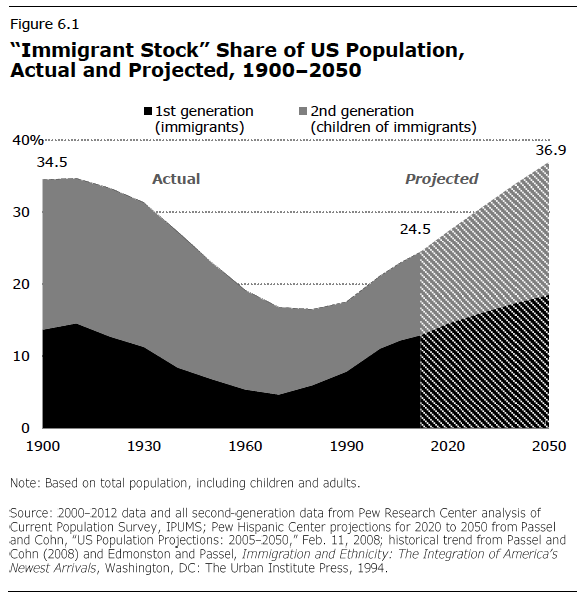
Today, fully half of immigrants are from Latin America, and more than a quarter (27%) are from Asia; Europeans make up just 12% of the current immigrant population. At the turn of the 20th century, 88% of all U.S. immigrants were from Europe.
—————————–
Today, the Pew Research Center is taking its show on the road — or at least down the road, to the Newseum in Washington, D.C. We’re hosting a one-day symposium on how the nation’s rapidly shifting generational makeup and racial/ethnic demographics are affecting American families, society, politics and policy. (Our event begins at 10 a.m. ET.)
In his new book, The Next America, Pew Research executive vice president of special projects Paul Taylor identifies two key trends that are already reshaping the United States and will continue doing so for decades to come. The first: far greater racial and ethnic diversity, driven largely by immigration. In 1960, the U.S. population was 85% white, 10% black and 4% Hispanic. By 2060 whites will be a minority (43%), while 31% of the population will be Hispanic, 13% black, 8% Asian and 6% other races or ethnicities. As Taylor puts it, “We were once a black and white country; now we’re a rainbow.”
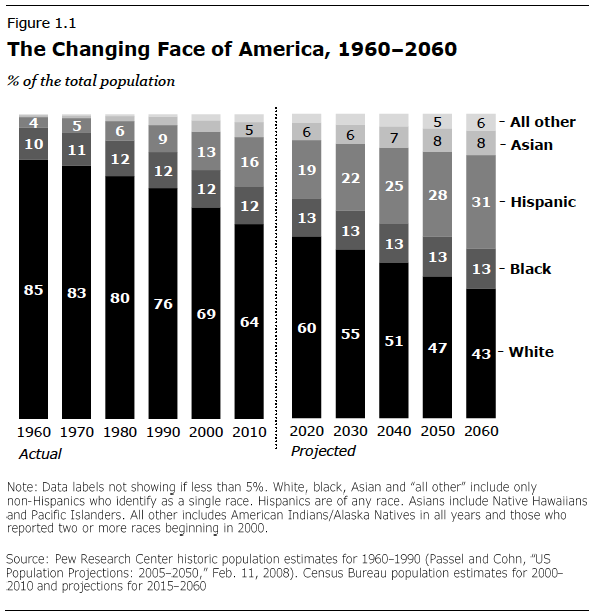
But there’s also going to be a lot more gray in that rainbow. Not only are some 10,000 Baby Boomers turning 65 every day (and will continue doing so till 203o), but Americans are living longer and having fewer children than ever. Result: The nation’s “age pyramid” is turning into more of a rectangle. That poses challenges for, among other things, Social Security. In 1960, near the peak of the Baby Boom, there were 5.1 workers for every Social Security-eligible retiree. By the time the last Boomer retires, that ratio will be down to 2 workers per retiree.
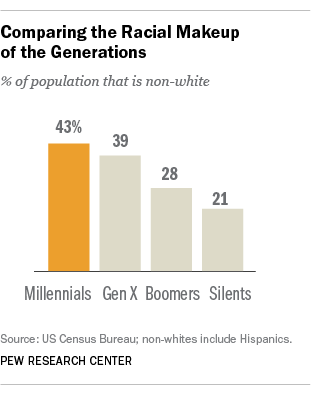
Whose job will it be to square that circle? Mainly the 80 million or so members of the Millennial generation, now anywhere from their teens to early 30s. That generation — currently the largest segment of the U.S. population — embodies the nation’s growing diversity: 43% of Millennials are non-white, the highest share of any generation. And while they’re much less trusting than their elders (only 19% say most people can be trusted, about half the level of Boomers), they’re also more optimistic about the future: 55% say that America’s best days are ahead of it, compared with 48% of Boomers.